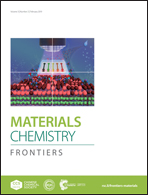Thiacalixarene “knot” effect on protein binding by oligolactic acid particles†
Abstract
Materials based on bioresorbable polymers and proteins have found wide ranging applications in biotechnology and in pharmaceutics to facillitate drug delivery. One of the key approaches to creating such systems is a bottom-up approach using a self-assembly method. In this article we report the effect of functionalization of oligolactic acid by a thiacalixarene “knot” on its self-organization and aggregation with proteins. Three carboxylic p-tert-butylthiacalix[4]arene derivatives were used in a copolycondensation with oligolactic acid, followed by a catalytic copolycondensation in the presence of tin(II) dioctoate. The most prominent increase in the oligolactide chain length was observed for the least sterically crowded macrocycle in the 1,3-alternate conformation. A slight decrease in the thermal stability of the (co)polyesters was also most prominently expressed for the oligolactic acid modified with a macrocycle in the 1,3-alternate conformation, which was established by simultaneous thermogravimetric and differential scanning calorimetry analysis. Linking the oligolactic acid fragments by using macrocyclic “knots” results in an increase in their affinity towards the proteins studied. Using fluorescent spectroscopy it was established that the most effective protein binding was observed for the oligolactic acids modified with the macrocyclic “knot” in the cone and partial cone conformations. A distinct feature of the binding is the formation of stable nanosized systems with transport proteins (bovine serum albumin and hemoglobin), while aggregation with lysozyme results in large precipitating structures.



 Please wait while we load your content...
Please wait while we load your content...